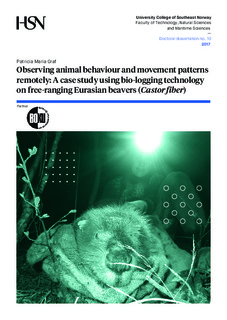| dc.contributor.author | Graf, Patricia Maria | |
| dc.date.accessioned | 2018-02-14T09:53:20Z | |
| dc.date.available | 2018-02-14T09:53:20Z | |
| dc.date.issued | 2017-02-24 | |
| dc.identifier.isbn | 978-82-7206-423-4 | |
| dc.identifier.issn | 2464-2843 | |
| dc.identifier.uri | http://hdl.handle.net/11250/2484545 | |
| dc.description.abstract | Understanding animal behaviour is a fundamental part of biology and has been revolutionized by the invention of bio-logging units, which can be used to study wild animals in their natural habitats. In this thesis, tri-axial accelerometers and GPS systems were used to examine activity, behaviour and movement patterns of dominant, free-living Eurasian beavers (Castor fiber) (n = 33; 19 males, 14 females) in southeast Norway. We investigated whether accelerometry data could be used to study beaver behaviour, and, by using a random forest classifier, were able to identify seven different behaviours (standing, walking, swimming, feeding, grooming, diving and sleeping). Capture and tagging can be stressful, and, thus, changes in activity and movement patterns were examined for the first week after the tagging event. There was a lower post-release activity; however, the small effect size indicated that it was likely minor. We applied these results when studying movement patterns and the diving behaviour of beavers. Movement patterns in water and on land were linked to territory size and individual age. There was a trade-off between foraging and patrolling: beavers in larger territories patrolled more, but stayed closer to the shoreline when foraging, while this relationship was reversed in smaller territories. Movement patterns also changed with increasing age: older beavers spent more time on land and within absolute border zones, which may be linked to increased experience of dominant territory holders with time. Beavers dived during only 2.8% of their active time and the majority of dives where short and shallow. Maximum diving depth and dive durations (total and bottom phase) were defined by the physical effort during the descent and bottom phases and the maximum depth reached, while water temperature had no effect. Lastly, to advance analyses of accelerometry data, we provide researchers with software for visualizing behavioural data coupled with proxies for power use, or any other parameter of interest. This thesis emphasizes the power of accelerometers and GPS systems for determining beaver behaviours, ranging from the construction of ethograms, to evaluating tagging effects, to gaining detailed insights into the beavers’ movement patterns and diving performance, and reinforces the field by introducing a new software tool for the analysis of such data. | nb_NO |
| dc.language.iso | eng | nb_NO |
| dc.publisher | University College of Southeast Norway | nb_NO |
| dc.relation.ispartofseries | Doctoral dissertations at the University College of Southeast Norway;10 | |
| dc.relation.haspart | Paper I: Graf, P.M., Wilson, R.P., Qasem, L., Hackländer, K. & Rosell, F.: The use of acceleration to code for animal behaviours: a case study in free-ranging Eurasian beavers Castor fiber. PLoS One 10(2015), e0136751. http://dx.doi.org/10.1371/journal.pone.0136751 | nb_NO |
| dc.relation.haspart | Paper II: Graf, P.M., Hochreiter, J., Hackländer, K., Wilson, R.P. & Rosell, F.: Short-term effects of tagging on activity and movement patterns of Eurasian beavers (Castor fiber). European Journal of Wildlife Research 62(2016), 725-736. http://dx.doi.org/10.1007/s10344-016-1051-8 | nb_NO |
| dc.relation.haspart | Paper III: Graf, P.M., Mayer, M., Zedrosser, A., Hackländer, K. & Rosell, F.: Territory size and age explain varying movement patterns in the Eurasian beaver. Mammalian Biology 81(2016), 587-594. http://dx.doi.org/10.1016/j.mambio.2016.07.046 | nb_NO |
| dc.relation.haspart | Paper IV: Graf, P.M., Wilson, R.P., Cohen Sanchez, L.G., Hackländer, K. & Rosell, F.: Diving behaviour in a free-living, semi-aquatic herbivore, the Eurasian beaver Castor fiber. Manuscript. Published in Ecology and Evolution 8(2), (2017). https://doi.org/10.1002/ece3.3726 | nb_NO |
| dc.relation.haspart | Paper V: Wilson, R.P., Holton, M.D., Walker, J.S., Shepard, E.L.C., Scantlebury, D.M., Wilson, V.L., Wilson, G.I., Tysse, B., Gravenor, M., Ciancio, J., McNarry, M.A., Mackintosh, K.A., Qasem, L., Rosell, F., Graf, P.M., Quintana, F., Gomez-Laich, A., Sala, J.-E., Mulvenna, C.C., Marks, N.J. & Jones, M.W.: A spherical-plot solution to linking acceleration metrics with animal performance, state, behaviour and lifestyle. Movement Ecology 4(2016), 22. http://dx.doi.org/10.1186/s40462-016-0088-3 | nb_NO |
| dc.rights | Navngivelse-Ikkekommersiell-DelPåSammeVilkår 4.0 Internasjonal | * |
| dc.rights.uri | http://creativecommons.org/licenses/by-nc-sa/4.0/deed.no | * |
| dc.subject | acceleration | nb_NO |
| dc.subject | activity | nb_NO |
| dc.subject | behaviour | nb_NO |
| dc.subject | Castor fiber | nb_NO |
| dc.subject | Eurasian beaver | nb_NO |
| dc.subject | GPS | nb_NO |
| dc.subject | spatial movement | nb_NO |
| dc.title | Observing animal behaviour and movement patterns remotely: A case study using bio-logging technology on free-ranging Eurasian beavers (Castor fiber) | nb_NO |
| dc.type | Doctoral thesis | nb_NO |
| dc.description.version | publishedVersion | nb_NO |
| dc.rights.holder | © 2017 Patricia Maria Graf, except otherwise stated | nb_NO |
| dc.subject.nsi | VDP::Mathematics and natural science: 400::Zoology and botany: 480::Ecology: 488 | nb_NO |

